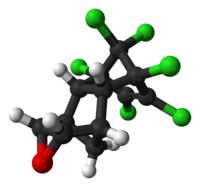Dieldrin
 |
|
 |
|
| Names | |
|---|---|
|
IUPAC name
(1aR,2R,2aS,3S,6R,6aR,7S,7aS)-3,4,5,6,9,9-hexachloro-1a,2,2a,3,6,6a,7,7a-octahydro-2,7:3,6-dimethanonaphtho[2,3-b]oxirene
|
|
| Other names
Dieldrin, HEOD
|
|
| Identifiers | |
|
60-57-1 |
|
| 3D model (Jmol) | Interactive image |
| ChEBI |
CHEBI:34696 |
| ChEMBL |
ChEMBL481118 |
| ChemSpider |
10292746 |
| ECHA InfoCard | 100.000.440 |
| KEGG |
C13718 |
| PubChem | 969491 |
| UNII |
I0246D2ZS0 |
|
|
|
|
| Properties | |
| C12H8Cl6O | |
| Molar mass | 380.91 g/mol |
| Appearance | colorless to light tan crystals |
| Density | 1.75 g/cm3 |
| Melting point | 176 to 177 °C (349 to 351 °F; 449 to 450 K) |
| Boiling point | 385 °C (725 °F; 658 K) |
| 0.02% | |
| Hazards | |
| Main hazards | potential carcinogen |
| Flash point | noncombustible |
| Lethal dose or concentration (LD, LC): | |
|
LD50 (median dose)
|
45 mg/kg (oral, rabbit) 49 mg/kg (oral, guinea pig) 38 mg/kg (oral, mouse) 65 mg/kg (oral, dog) 38 mg/kg (oral, rat) |
|
LC50 (median concentration)
|
80 mg/m3 (cat, 4 hr) 13 mg/m3 (rat, 4 hr) |
| US health exposure limits (NIOSH): | |
|
PEL (Permissible)
|
TWA 0.25 mg/m3 [skin] |
|
REL (Recommended)
|
Ca TWA 0.25 mg/m3 [skin] |
|
IDLH (Immediate danger)
|
Ca [50 mg/m3] |
|
Except where otherwise noted, data are given for materials in their standard state (at 25 °C [77 °F], 100 kPa).
|
|
|
|
|
| Infobox references | |
Dieldrin is an organochloride originally produced in 1948 by J. Hyman & Co, Denver, as an insecticide. Dieldrin is closely related to aldrin, which reacts further to form dieldrin. Aldrin is not toxic to insects; it is oxidized in the insect to form dieldrin which is the active compound. Both dieldrin and aldrin are named after the Diels-Alder reaction which is used to form aldrin from a mixture of norbornadiene and hexachlorocyclopentadiene.
Originally developed in the 1940s as an alternative to DDT, dieldrin proved to be a highly effective insecticide and was very widely used during the 1950s to early 1970s. Endrin is a stereoisomer of dieldrin.
However, it is an extremely persistent organic pollutant; it does not easily break down. Furthermore, it tends to biomagnify as it is passed along the food chain. Long-term exposure has proven toxic to a very wide range of animals including humans, far greater than to the original insect targets. For this reason it is now banned in most of the world.
It has been linked to health problems such as Parkinson's, breast cancer, and immune, reproductive, and nervous system damage. It is also an endocrine disruptor, acting as an estrogen and antiandrogen, and can adversely affect testicular descent in the fetus if a pregnant woman is exposed to it.
Dieldrin can be formed from the synthesis of hexachloro-1,3-cyclopentadiene with norbornadiene in a Diels-Alder reaction, followed by epoxidation of the norbornene ring.
...
Wikipedia
